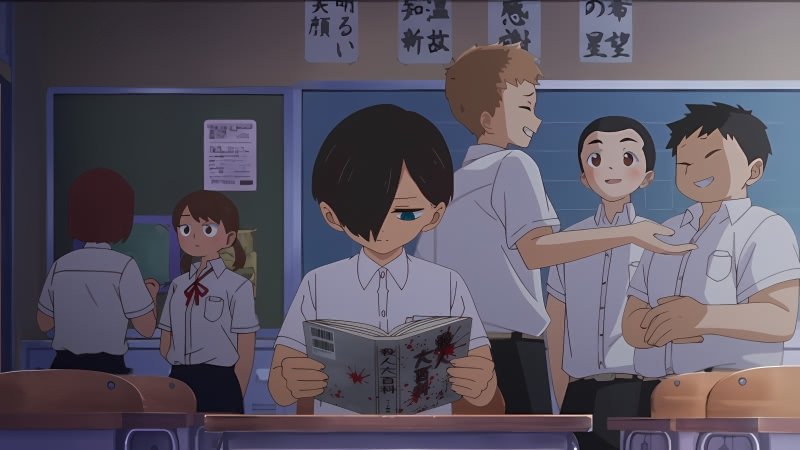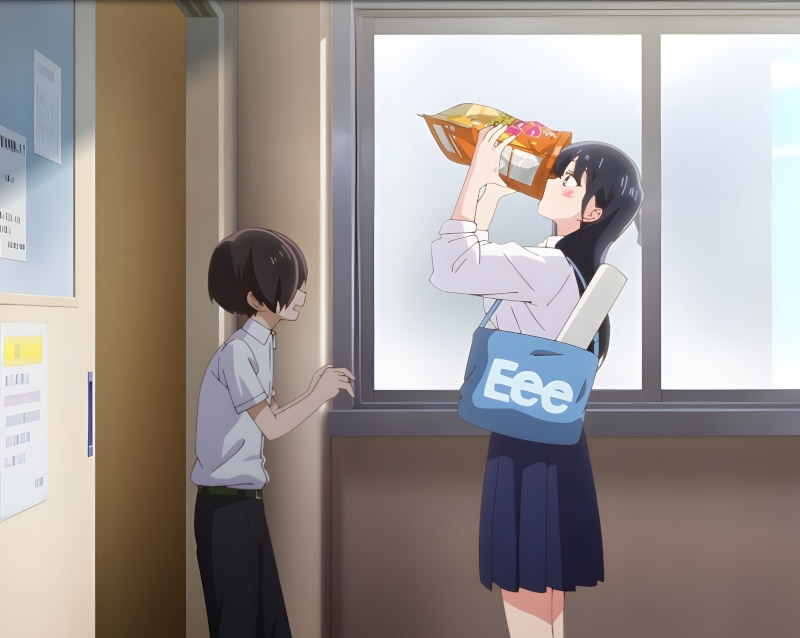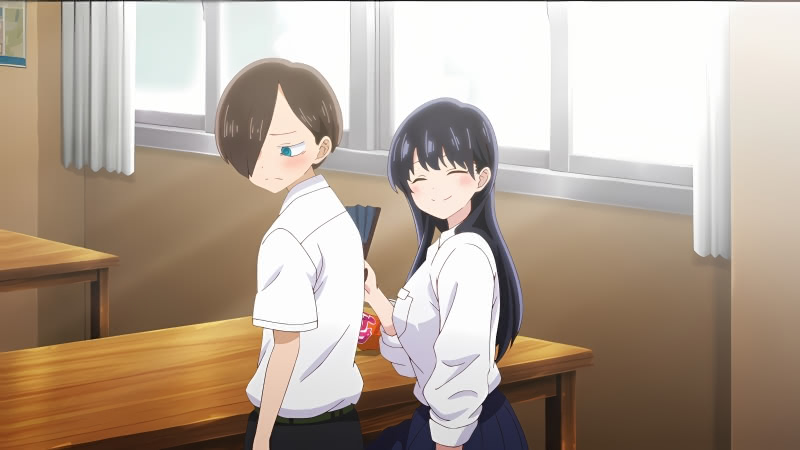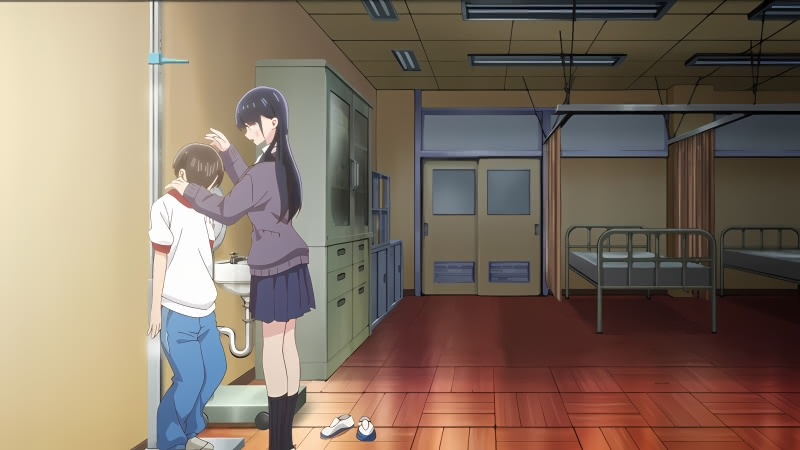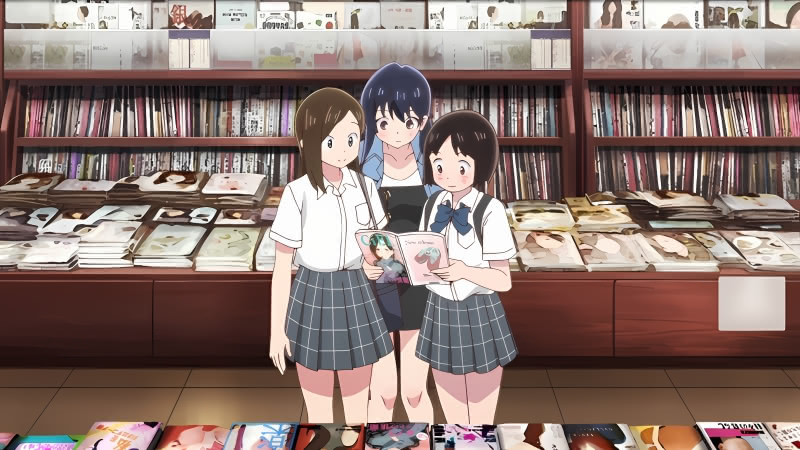The Dangers in My Heart (Boku no Koboro no Yabai Yatsu) is a Japanese manga series by Norio Sakurai. I am not familiar with the manga, but I did watch the first season of the anime adaptation, which aired from April 2, 2023 to June 18 of the same year, as it aired. The Dangers in My Heart is receiving a second season beginning in January 2024. With the second season fast approaching, I decided it would be interesting to write a short review (by our review-length standards) of the first season for the uninitiated. Note that while I will discuss the characters and plot in general terms, I will not spoil specific key events – so my review should be appropriate reading for people who have watched the series or people who are open to considering catching up on it in the future.
(Note on screenshots: I took all of the screenshots myself but ran them through Upscayl before formatting them to increase the their sharpness.)
(April 28, 2024 Update: I also reviewed the second season.)
General Plot Overview
The Dangers in My Heart is set in a middle school. The main and view-point character is Kyotaro Ichikawa, who is voiced by Shun Horie. Kyotaro is short, skinny, and makes a point of dressing darkly – we can say goth or emo-esque. Kyotaro makes a strong, not great, first impression – with the series beginning with his internal monologue about how he is “dangerously unstable” and “messed up in the head” while inventing fantasies about murdering his classmate, Anna Yamada. Lest anyone doubt Kyotaro (note he appears to be a loner in class), he makes a point of toting a murder encyclopedia to school. However, in light of the fact that Kyotaro appears innocuous at school, keeps to himself, and stammers whenever he has to talk to someone – there is little evidence that his classmates think much about him at all.
Of course, as we quickly see, Kyotaro arguably suffers from what is colloquially called chuunibyou syndrome, an affliction usually particular to middle school students, usually, but not always, boys. Usually when this appears in anime or manga, we have a middle school student with delusions that he or she has super powers and is fighting a secret organization. Kyotaro, however, has a more visceral delusion that is more creepy than the usual merely annoying version in the animated medium (I grant the possibility that it played a little bit differently in manga form). Like less creepily afflicted sufferers, Kyotaro wants to imagine himself as being special or unique in some way. However, a reasonably astute viewer should quickly infer that Kyotaro has created a twisted fantasy world in his mind in order to construct a framework for his social isolation and, perhaps, a justification for not making any effort to make friends or, for lack of a better term, improve himself.
Anna Yamada (voiced by Hina Yōmiya), the subject of Kyotaro’s early-episode unsettling fantasies, is the second main character of the series, albeit we see the all events from Kyotaro’s perspective. Anna is tall, looks old than her age, and is attractive – such that she works as a model. However, while Anna looks older than she is, we, and Kyotaro, quickly see that she is kind, silly, and characterized by by her big appetite – sneaking all sorts of snacks into the school library between classes. Kyotaro also often goes to the library in between classes, likely on account of being a loner.
Kyotaro’s and Anna’s relationship begins, so to speak, in the library – when Kyotaro throws himself on a proverbial sword on several occasions to save Anna when he perceives her as waltzing into trouble of one sort or another. They have a few brief interactions early in the series before Anna takes an interest in getting to know Kyotaro, who struggles to interact with her because of his own social awkwardness, but they slowly develop the ability to carry out conversations, which leads to them getting to know one another.
Through Kyotaro’s interactions with Anna, his world opens up a little. While the first season does not see him stumble into a friend group or completely escape his social isolation, he slowly talks to some people he would have never talked to when he was clutching his murder book and basking in his strange delusions. We see, over time, that as Kyotaro gets over himself, he is intelligent, introspective (perhaps to a fault), and cares about others (namely Anna, but not only Anna).
While the first season of Dangers in My Heart leaves plenty to do in the second season, Kyotaro makes a great deal of personal progress – beginning the series as a self-loathing boy hiding in his warped fantasies and ending with him having made great progress in shedding his anti-social tendencies and having gained a genuine friend (and perhaps more) in Anna.
The Dangers in My Heart Details
Before proceeding to my review, let us look at the technical points of season one of The Dangers in My Heart.
| English Title | The Dangers in My Heart |
| Japanese Title | Boku no Kokoro no Yabai Yatsu |
| Aired | April 2, 2023 to June 18, 2023 (12 episodes) |
| Studio | Shin-Ei Animation |
| Director | Hiroaki Akagi |
| Links | Wikipedia; ANN; MAL; AnimeDB |
The series has a good pedigree (from my perspective) with its director. Mr. Akagi directed all three seasons of Teasing Master Takagi-san, the final season of which was my choice for anime series of the year in 2022. Takagi, like Dangers, is a middle-school romance story – so I will say it had the right director. The studio, Shin-Ei Animation, is a long-standing studio perhaps best known for the long running Crayon Shin-chan, but the only one of its recent series that I am particularly fond of is Takagi-san.
My Review
My overall impression of The Dangers in My Heart is mixed, in large part because one of its selling points – its particularly visceral look into the mind of an anti-social kid – makes it an often uncomfortable watch in the early going. Kyotaro gets over the worst of his creepy mental tendencies by the end of the third episode (which coincidentally provides his creepiest moment) – and the show becomes much more watchable for it, and it concludes with a much stronger second half than first.
The early episodes can be difficult not only because of Kyotaro is mentally play acting as being a lunatic, but also because the series does not flinch in giving us access to his thoughts on being attracted to Anna (separate from his play acting). On one hand – I suppose it is an honest look into the mind of a middle schooler, but there is a reason that no one much likes middle schoolers (I was not a fan). So you end acknowledging that the series did not shy away from taking us into the head of a disturbed one while nevertheless wishing it did not. Interestingly, however, while Kyotaro fends off his own less-than-pure thoughts, he is often revolted (sometimes admirably so) by the crass way that some of the boys in his class talk about Anna and her friends. On several occasions he takes clandestine action to keep them from embarrassing Anna and her friends (granted, Anna is blissfully in her own world and some of her friends need little help in dealing with the juvenile tricks of some of the boys ). Thus, like with Kyotaro’s early-series fantasies, there is a distinction between the hamster wheel in his mind and his actual, real-world behavior (which, to his credit, he is aware of). I will note that like Kyotaro’s delusions of mental instability, his thoughts on Anna shift to her as a person as he gets to know her, with many of his later monologues being devoted to dissecting their interactions and trying to understand her feelings and motivations.
In general, Dangers is nothing like my 2022 anime of the year, Teasing Master Takagi-san, aside from the facts the same studio and director handled both anime adaptations and both focus on a middle school romance. However,, a tenuous comparison of them serves to highlight why the deep dives into Kyotaro’s mind can make Dangers difficult viewing. We almost always see Takagi-san from the perspective of the dense, awkward, but earnest male lead, Nishikata. We have access to his thoughts of being flustered by Takagi, who becomes increasingly forward in expressing her obvious (to everyone but Nishikata) attraction to Nishikata, but with Nishikata we see him blush and stammer whereas with Kyotaro we have him offer a full mental monologue of his feelings. Combine the fact that Nishikata comes off as a normal, not especially bright kid while Kyotaro is smart but anti-social, and we have yet another layer explaining why Takagi-san is usually fun and light-hearted while Dangers has the profound ability to make the viewer cringe.
Having watched the series, and granting in full disclosure that I am not familiar with the source material, I think the anime should have toned down Kyotaro’s dark fantasies in the first couple of episodes – and I especially think the anime erred in making the very first scene of the show a creepy Kyotaro monologue. It is hard for a show grounded almost entirely in the unfiltered thoughts of its protagonist to take a show-not-tell approach, but Dangers could have done with more of that in the early going. To be clear, I am not saying that Kyotaro’s delusions could or should have been entirely discarded – Kyotaro’s weird chuunibyo affliction and anti-social personality is a big part of his character’s personality, and his character development involves growing out of it. Nevertheless, the anime either went too far in highlighting the affliction or miscalculated that things that come off in one manner in a manga may come off very differently in a fully animated setting. By giving intimate access to his Kyotaro’s monologues is how Dangers presents the more common, base aspects of Kyotaro’s mind, so I suppose that is one area in which we have to accept the good and bad.
Having leveled my complaints and qualms about how the series handles Kyotaro, the worst of it is relegated to the first quarter of the 12-episode season, and later episodes show the strengths of Dangers’ particular approach to telling its story. Kyotaro is intelligent – which is evinced by the sophistication of his later, less weird monologues and hints that he is academically curious and at least somewhat academically inclined. Combined with his introspective tendencies, Kyotaro is consistently able to articulate his feelings and explain why he does one thing or another. We also see his weaknesses – for example his introspection and low self-valuation plays a role in his social awkwardness, causing him to over-think things and not always make accurate assessments about the relative position of the other person when it comes to him. Still, Kyotaro is generally sharp when he assesses the behavior of others as an impartial third party where their actions bear no direct relationship to him.
One credit to Kyotaro’s character and why, despite some significant caveats, he is one of the stronger characters in anime in 2023, is that he is not dense per se. For example, Anna takes an obvious liking (in a general sense) to Kyotaro early in the series and that morphs into more as the series goes on. Kyotaro is not oblivious but instead thinks himself into circles because he cannot imagine why anyone, especially a pretty, popular girl, would like him at all. Kyotaro also has a particular selfless streak (italics intended), as he tries to help people (usually, not not always exclusively, Anna) while trying to avoid being seen as helping or receiving any credit for it. While on one hand he often acts from good intentions, viewers can consider on the other hand whether this tendency of his plays into his self-identification as a misunderstood loner. This too adds to what is ultimately an interesting character study.
(Kyotaro”s weird early monologues are enough to detract from his somewhat voyeuristic early relationship with Anna, including in some of the scenes where he ultimately tries to do something for her benefit. Their relationship becomes more normal when she makes an effort to engage him in conversation.)
I wrote a short post on the significant (and unusual) height difference between the female and male leads of Dangers in My Heart in favor of the girl, Anna. As I noted, Anna is objectively attractive in the show’s world and works as a model. She is unusually tall and looks older than her age. One could say every aspect of her character design was designed to be marketable. As a character, however, Anna was decent – but a bit of a black box based solely on the first season.
Kyotaro’s initial, creepy impression of Anna, is that she is this perfect and attractive girl who would surely look down on those around her. We see quickly that Anna is quirky, goofy, a bit dense – always friendly but with some unexpected habits (the constant snack sneaking) and a certain obliviousness (including to personal space).
One gets the impression there is more going on between Anna’s ears than what her behavior sometimes suggests – for example she clearly picks up on Kyotaro’s playing (or trying to play) the role of unsung hero for her early in the series. Moreover, in taking the initiative in befriending Kyotaro, Anna necessarily picks up on his awkwardness and that he would be interested in getting to know her if she could get over the initial barriers he built around himself. Finally, although I am a bit limited in what I can say in this area, it does become clear over the course of their getting to know one another that Anna picks up on some key points of Kyotaro – notably his low opinion of himself. (There is no evidence as of yet that she picks up on his early and mercifully discarded “dangerously unstable” fantasies.) There are points in the latter half of the season where Anna is patient with Kyotaro, perhaps evincing some understanding that his social skills leave something to be desired.
However, one issue with the depiction of the character of Anna is the structure of Dangers of My Heart. The first season very strongly benefits Kyotaro’s development because close to 100% of the series is seen from his perspective. The only Anna we see see is through Kyotaro’s eyes and the only additional information we receive are a few late-season exchanges between Kyotaro and Anna’s friends. While the relationship between Kyotaro and Anna is a central focus of every episode, it takes a while – well into the second half – for them to consistently have non-stunted conversations. Even then, we still have Kyotaro being held back by his extreme reluctance to get ahead of himself or let himself be optimistic about the possibility that Anna actually likes him as a friend, much less as more.
In my short height post (pun intended), I questioned whether Dangers would be able to credibly sell the romance between the tall, popular model and a scrawny anti-social kid with no friends. In the end – the first season did better than I expected when I wrote that short post (which came after the first episode). I think Kyotaro’s and Anna’s relationship progressed carefully and deliberately throughout the first season. The series did establish that there is no evidence Anna had any particular interest in going out with or otherwise befriending an attractive or popular guy, at least based on superficiality. While Anna very much cares about what people think about her in some respects, she does not seem to be the kind of person who would be concerned with what people think about who she is friends with. But the jury is ultimately still out for me on the reason behind Anna’s feelings for Kyotaro because the limited interactions between them – even the meaningful ones in the last few episodes – leave many questions about Anna’s background. There are some interesting hints but the first season does not follow through on them or on t the precise steps she went through in her head as she pushed to make Kyotaro open up to her. Those answers will perhaps have to wait for season two.
Dangers should not be classified as a comedy, but it does have occasional comedic elements. It broadly has four species of comedy: (1) Kyotaro being creepy in the early episodes; (2) Anna being a generally endearing doofus; (3) Kyotaro reminding us that he struggles when he actually has to talk to someone; and (4) Kyotaro witnessing an impending social train-wreck that the people involved are oblivious to and trying to think of a way to stop it before it is too late. Point one can be difficult to watch and I think Dangers to some extent miscalculated in thinking it could play some of Kyotaro’s early-episode fantasy life as comedic. Point two can be funny, but I think the series leans too much on Anna being weird in the early episodes – she ends up being more charming and amusing once Kyotaro, and by extension the viewer, getsto know her beyond the joy she finds in snacks and her blithe reveries. Point three, Kyotaro’s own awkwardness, is played for lighthearted cringe comedy – for example when he enthusiastically uses a childish (for lack of a better term) mannerism in an interaction with Anna – only to be saved by Anna and her rose-colored glasses perceiving it as cool. Dangers’ best comedy comes in those moments when Kyotaro sees an impending awkward social situation that the participants are blindly walking into. Even as he and, perhaps like the viewer, is trying to think of a way to avert itit is hard for him to watch (success rate varies). While some skits are better than others, the comedy having to do with Kyotaro’s observing things is where the first season shows its best understanding of how to deliver humor.
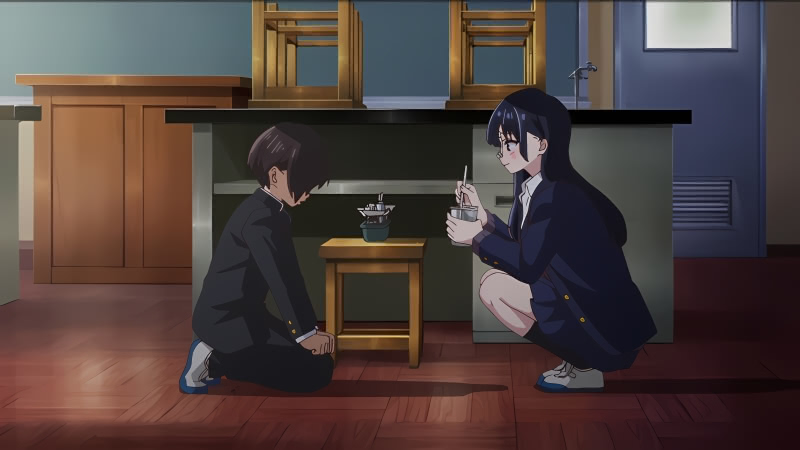
The Dangers in My Heart had above average production values for a middle school romantic comedy despite having little in the way of action to demand them. The quality is generally consistent from episode to episode, and quirks (a character occasionally being off model or an odd shadow, see above) did not distract me as a viewer. It was comparable to the quality the studio produced in Takagi-san, in that it was solid, pleasant, and more than good enough for a down-to-Earth series. There were some cases wherein Anna ended up looking too distinct from everyone around her, but this is a minor qualm. The opening theme, Shaoyou by yorushika, and the accompanying animation, made for one of the better opening or ending sequences of 2023. The ending theme, Suu Sentimental by Kohana Lam, was also well above average but the accompanying visuals lacked animation, instead featuring a slideshow of photos presumably from Anna’s modeling shoots.
Conclusion
The Dangers in My Heart comes with baggage, some of which is a necessary consequence of Kyotaro telling his story and some of which could have been toned down a bit in the first few episodes for the series’ benefit. Its second half is strong and, issues and all, Kyotaro is ultimately a well-written and interesting character – especially for a genre that is not always associated with producing such characters.
Taking the good and the bad of season one of Dangers, it tops out at a touch above average – with a decidedly above average second half compensating for a sometimes-rocky first half. The first season ends in a strong place – resolving enough given that this is an ongoing project and setting up clear questions and points to build on for season two. However, granting that it ends well – the first season’s story is not nearly as complete on its own as another 2023 romance that I reviewed and that will see its second season soon, The Angel Next Door Spoils Me Rotten (see my review).
(April 28, 2024 Update Note: The following recommendation paragraph is based solely on my opinion of the first season before the second season aired. I subsequently watched and reviewed the second season. I was very impressed with season two and for reasons I explain in that review, I now give the first season a higher recommendation based on its leading into the excellent second season.)
In general, slightly above average would entail a qualified recommendation. In Dangers case, I give the first season a very qualified recommendation in a vacuum (meaning without reference to the soon-to-air second season) because its unpleasant early quirks and general subject matter is not for everyone. I gave two of the previous six anime of the year awards to middle school romances – 2017’s Tsuki ga Kirei and 2022’s third season of Teasing Master Takagi-san. Both of those had plenty to fall back on beyond the mental health of their middle school characters. Tsuki ga Kirei is a sublime, understated production that stands as a text book example of using anime as a medium to show instead of tell. Takagi-san is one of the all-time great anime comedies separate and apart from the substantial relationship development in the late second and third seasons. Even separate from some of the uncomfortable aspects of Danger’s up close and personal look at Kyotaro, this is, at its core, a season very much focused on a middle school boy working through his thoughts and inhibitions. However, a strong second season (and/or potential later seasons) could affect my ultimate assessment of the first season in the context of the broader series.
I conclude by noting that I have some optimism – without any familiarity with the source material – that Dangers will have a better second season than first. The first improved markedly in its second half as Kyotaro shed some of his initial weirdness and began to get to know Anna. With some of the things that held Dangers back in season one in the past, I hope that we will learn more about Anna and perhaps some of the side characters given that she and Kyotaro end the first season as, at a minimum, good friends. The second season could, ideally, highlight the inherent strengths that came through at times in the first season – and contend for one of my top-six ranking spots for 2024 in the process.
April 28, 2024 Update: I reviewed the second season of The Dangers in My Heart after it aired. As I noted, I had a much more positive impression of season two than I did of season one.
